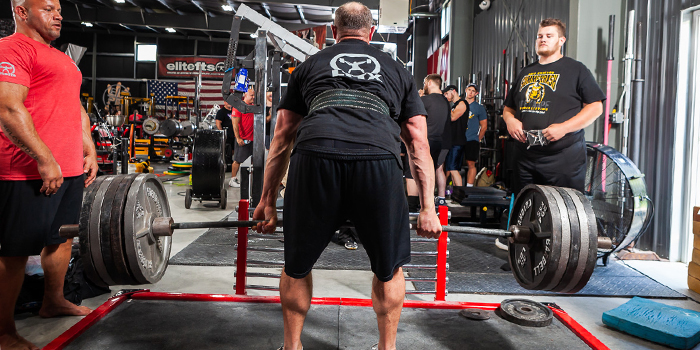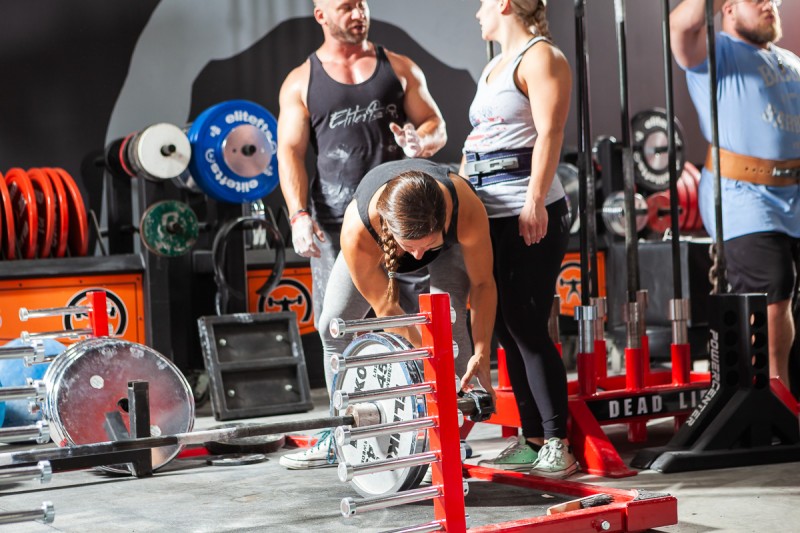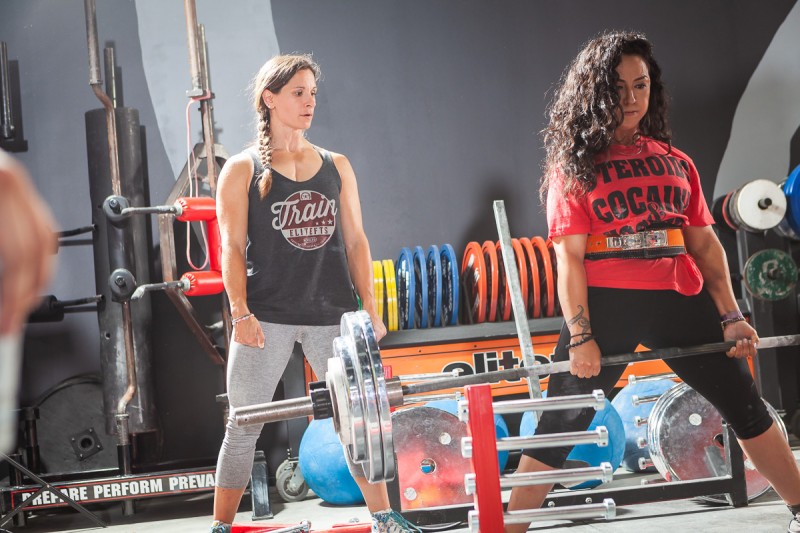
The one repetition maximum (1RM) is the ultimate test of absolute strength and power. High-level Olympic lifters and a certain portion of high-level powerlifters (primarily conjugate- or concurrent-based athletes) use relatively frequent 1RMs, as it is the most specific way of indicating progress or assessing current form.
This is in contrast to the world of strength and conditioning and beginning- and intermediate-level powerlifting and Olympic lifting, where the majority of people argue that a 1RM/single is too advanced of a practice or too dangerous to perform for people who aren’t advanced in their lifting.
Many arguments are made saying that the increased load of the 1RM/singles leads to them being more dangerous than the lighter load of a 3, 5, 8RM, etc. which, in very general terms may be true, but this leaves a lot of information unused. Muscle physiology dictates that the longer the exertion goes, the worse technique becomes. This is apparent in, quite obviously, aerobic-based sports and in anaerobic-based sports. If one watches a 100m or 200m race, even at the international level, technique will always be worse as fatigue sets in, not dissimilar to any other sport.
RECENT: The Split Squat, Its Variations, and Why Shin Angle Trumps All
This opinion, for some reason, changes as a barbell is put into the picture, which really shouldn’t be the case. Direct research in regards to the safety of the performance of 1RMs within open chain movements is limited, but given the high number of research studies including the 1RM back squat, deadlift, etc., that include very minute injury rates (see reference 4 for an example of a study with zero injuries; this is one among thousands), one can assume that safety is not a major issue in regards to the 1RM, assuming sound technique and weight selections are being used. Additionally, the performance of 1RMs in closed chain movements in higher-risk populations, such as the elderly (see reference 3) and youth (see reference 1), has been shown to be a safe procedure.

The Single, the Heavy Single, and the 1RM
Where part of the problem lies is in the assumption that a single should always or usually be heavy or maxed. The single, the heavy single, and the 1RM should really be seen as three different terms entirely:
The single is something that every strength training participant should use, no matter how far into the training process the person is. The single is mostly seen in a rep scheme of 10x1, 18x1, etc. The single should primarily be used in regards to the Olympic lifts and is most beneficial for the complete beginner lifter.
The single should mostly be done at a weight where the beginning lifter is at no risk of missing a lift. With the lack of fatigue that happens from a single, this easily allows for the most efficient type of rep scheme in terms of teaching technique and building a base in beginners who are inconsistent with their technique, most notably when using the Olympic lifts.
The heavy single is something that one should be slightly more well-practiced to perform but still should be used in beginning to intermediate lifters as long as they are consistent in their technique at weights that aren’t very challenging to them. The primary purpose of the heavy single is to find the weight where technique begins to falter and to eventually begin building confidence while using heavier weights.
Using (relatively) heavy weights is an unnerving thing to get used to at the beginning of the training process, and confidence can be a difficult thing to build. Similar to the reasoning behind using the single, having no fatigue when going into every repetition allows the lifter to focus on cues and correct movement patterns, thus speeding up the process of building good technique and confidence, far faster than solely performing sets of three, five, eight, and above.
The 1RM is something that is used for more advanced lifters. It is generally used with people who have the technique and strength to make a lift of at least 90 percent look the same or very similar to submaximal weights. It is used when somebody knows their technique will hold when attempting maximum weights. Generally, 1RMs are more frequently used in a competitive lifter’s program, but they definitely still have their place in a well-trained athlete’s program.
Knowing the difference between the single, the heavy single, and the 1RM is a very under-utilized aspect of programming. Being ignorant of the single because it is thought of as too advanced a practice for the beginning trainee (and is constantly thought of as a 1RM) can leave a large gap in the developmental training process of the beginner.

Why the Single/Heavy Single is Safer for the Beginner and Intermediate Lifter
The beginner and intermediate lifter, which almost every strength and conditioning participant will fall under, is inexperienced because of their lack of control, lack of technical proficiency, and lack of strength in places where strength is needed. How a beginner advances to intermediate is by consciously training correct movement patterns and by becoming proficient at the important movement patterns. The following is why the single, the heavy single, and the 1RM should be present in the training program, no matter how advanced the athlete is.
The average squat takes between three to five seconds. Three to five seconds is a very reasonable length of time to hold one’s focus for and to concentrate on specific cues that will enhance performance and prevent injury. Muscular fatigue will also not play a considerable role during such a time period.
For every squat that is performed following the initial first repetition, muscular fatigue becomes more apparent, and focus becomes harder to hold. For example, when an 8RM is being performed, one will have to stay focused for 24 to 40 seconds, all while being in a state of muscular fatigue.
MORE: Physics Made Easy to Increase Your 1RM
The discrepancy between the first, second, and recurring reps even becomes more apparent when the Olympic lifts are being discussed, given the muscular co-ordination needed. A full snatch takes a similar amount of time as the back squat (three to six seconds); however, the muscular co-ordination involved leads to muscular fatigue becoming a far larger factor than in the back squat or deadlift.
Because of this, the coach’s hesitation to perform singles with beginning athletes can drastically slow down the training process and the development of the athlete, in particular to the Olympic lifts. When learning the snatch, clean, or jerk, 6x3 is an often used set/rep scheme to teach beginners. However, using this scheme, (from the 18 reps performed) the athlete will have sufficient energy to be adequately focussed for 6-12 repetitions. As the movement is not yet habitual, muscular fatigue will, in general play a large factor going into repetition three, that the last rep will be far more difficult to perform properly than the initial two.
Whereas if the athlete were to perform an 18x1 scheme or a similar scheme focusing more on singles than doubles or triples, far more focus and concentration can be placed into performing each lift correctly and will often lead to more lifts being performed well. This may not be the case all the time, but the use of multiple singles is a far safer bet for technical purposes than the double and especially the triple.
Conclusion
Knowing when and where to use all the tools of the training program is of great benefit to the coach and to the athlete. The benefits of using high rep sets and accumulating volume while using weights at sub-maximal percentages are more than well-known and are used in every weightlifting, powerlifting, or strength and conditioning program out there. However, the use of singles (whether it be through accumulation of volume, finding a max, or easy technique work) is under-utilized and is very seldom used in regards to beginners because of “injury risk” or the notion that the single is too advanced of a practice for beginners.
A change of perspective in regards to the single and knowing that it doesn’t always have to mean the heaviest that you can go will be very beneficial to many a program. The single is useful for everybody, and is, ironically, most beneficial for the people who are most rarely exposed to it.
Coaches generally believe that beginners and intermediates should start with mid-high repetitions to build a base in beginning and intermediates. However, learning how to do one repetition greatly should always be a prerequisite to learning how to do five repetitions greatly, just like anything else in life.
References
- Faigenbaum, A.D., Milliken, L.A., & Westcott, W.L. (2003). Maximal strength testing in healthy children. Journal of Strength and Conditioning Research, 17(1), 162-166.
- Faigenbaum, AD, McFarland, JE, Herman, RE, Naclerio, F, Ratamess, NA, Kang, J, and Myer, GD. (2012). Reliability of the one repetition-maximum power clean test in adolescent athletes Journal of Strength and Conditioning Research 26(2): 432–437.
- Shaw, C.E., McCully, K.K. and Posner, J.D., 1995. Injuries during the one repetition maximum assessment in the elderly. Journal of cardiopulmonary rehabilitation, 15(4), pp.283-287.
- McBride, J.M., Blow, D., Kirby, T.J., Haines, T.L., Dayne, A.M. and Triplett, N.T., 2009. Relationship between maximal squat strength and five, ten, and forty yard sprint times. The Journal of Strength & Conditioning Research, 23(6), pp.1633-1636.
Noel FitzGibbon is a former international, underage level weightlifter who has represented Ireland at a European level and has achieved a World Ranking with the IWF. He has coached in strength and conditioning and weightlifting/powerlifting at a provincial, national and international level. He is currently working as a personal trainer and a strength and conditioning coach out of Calgary, Canada.











2 Comments